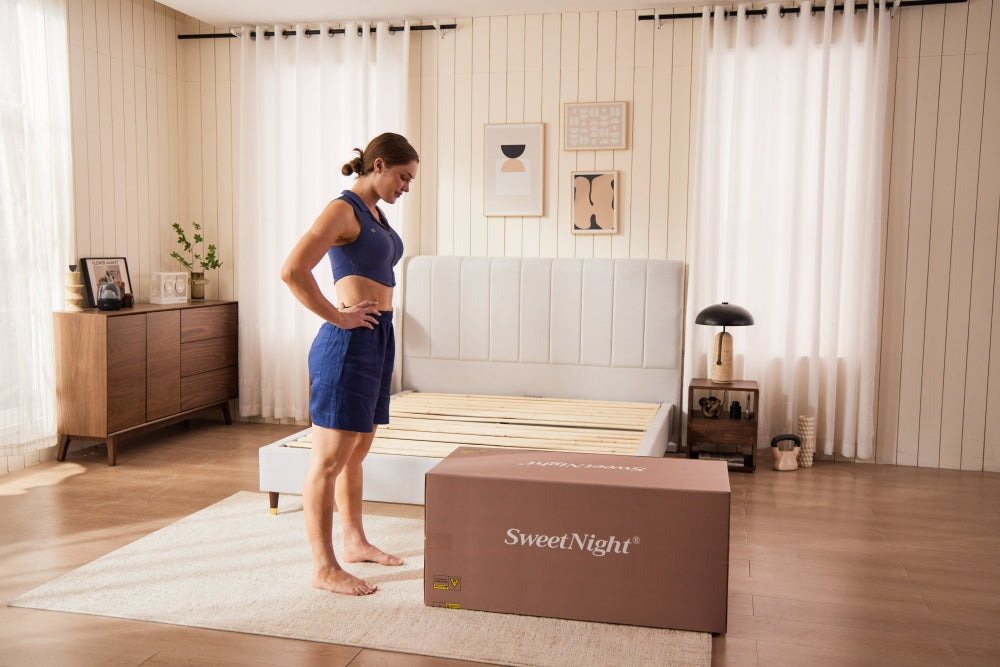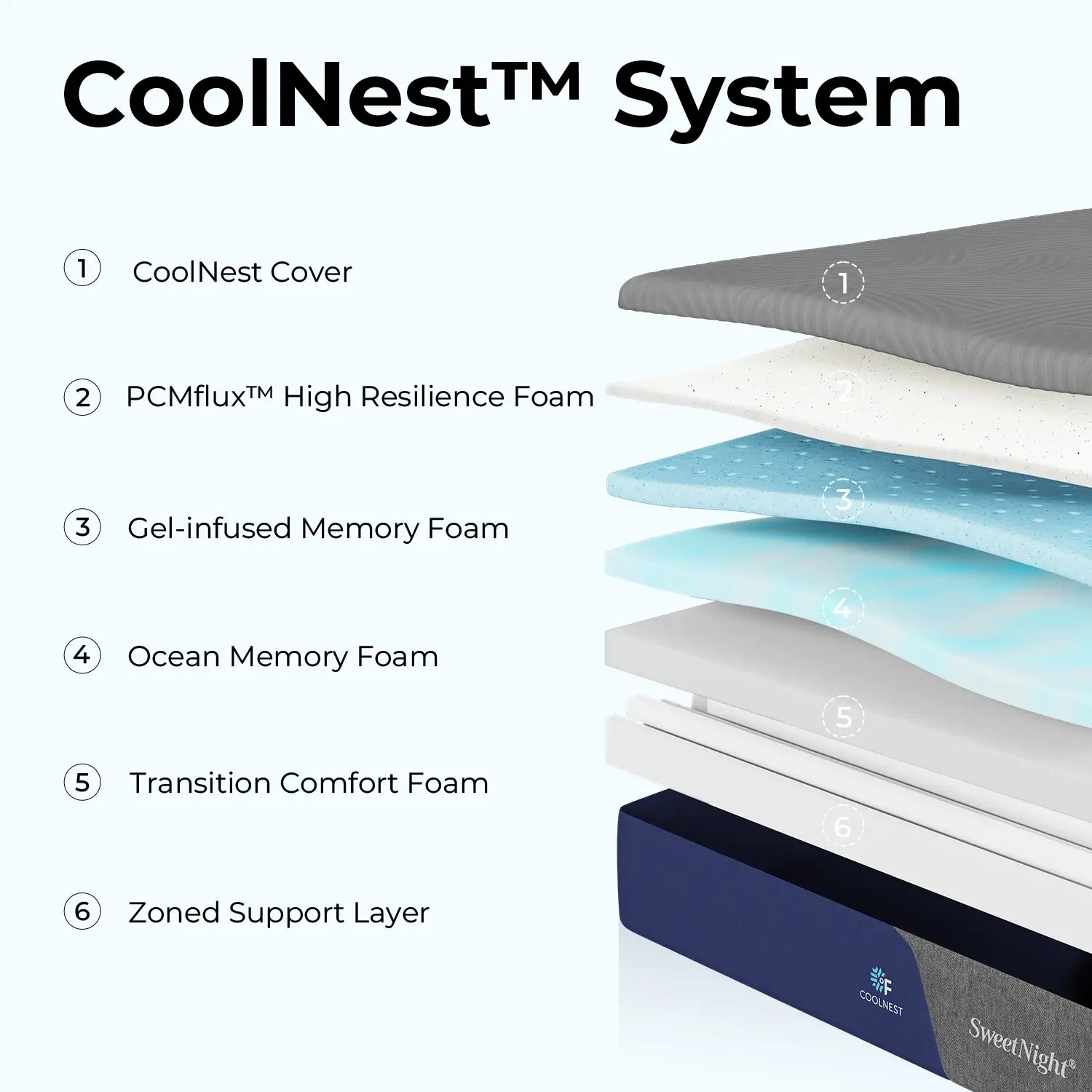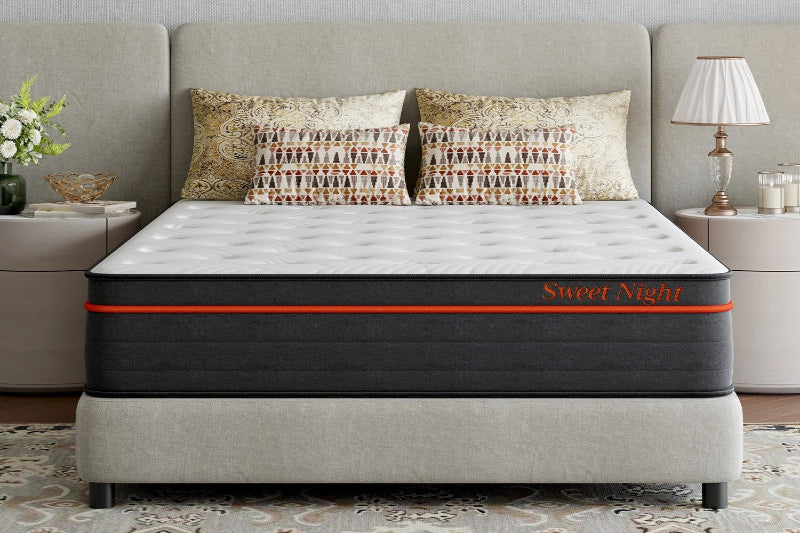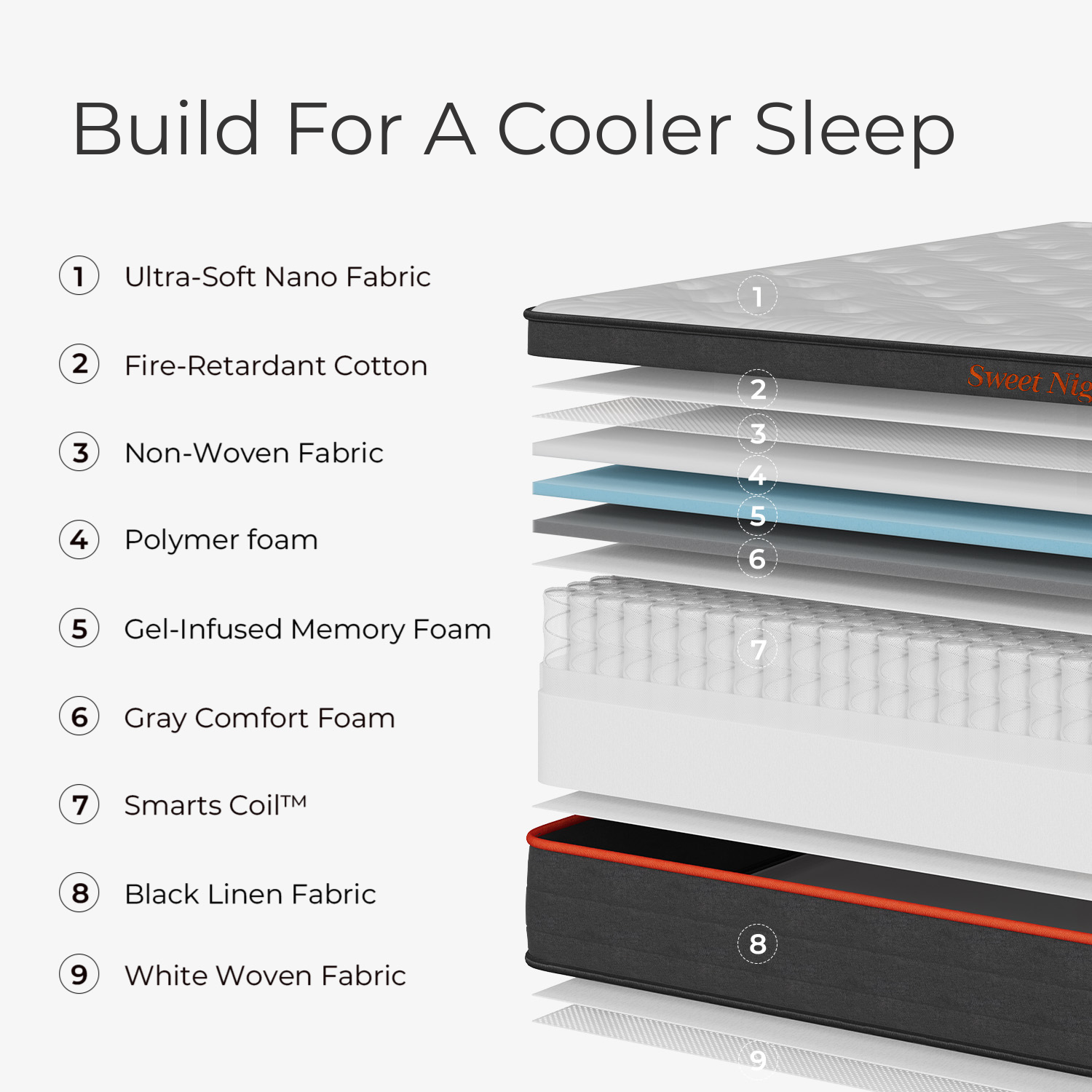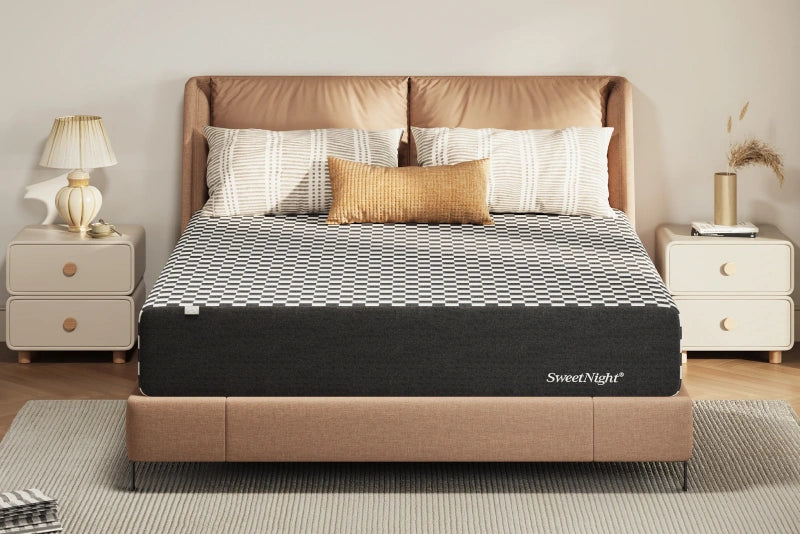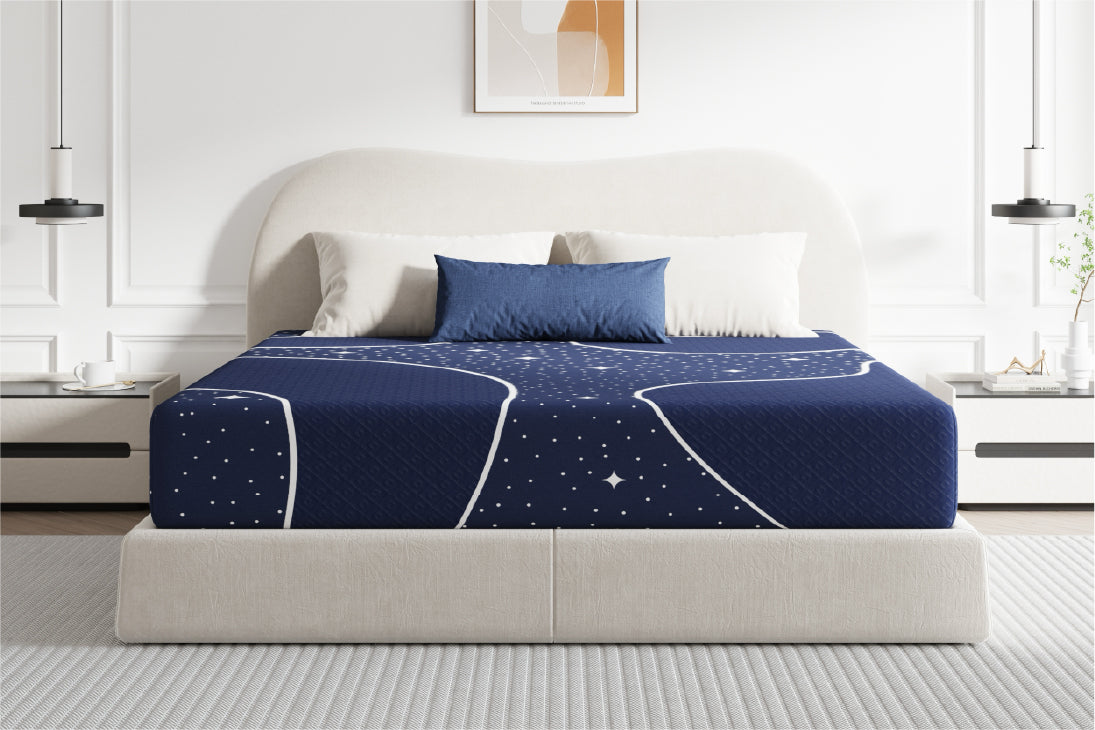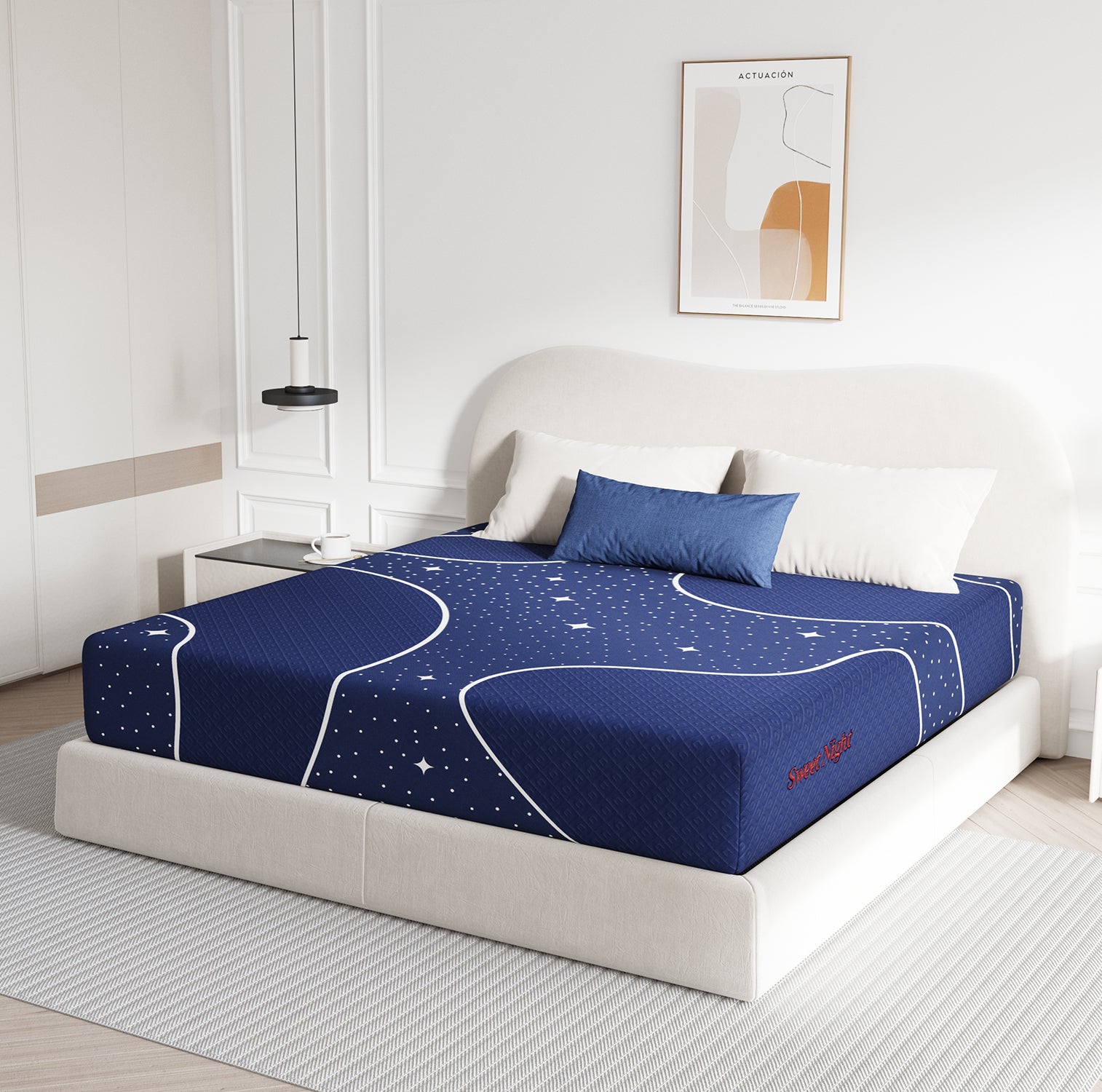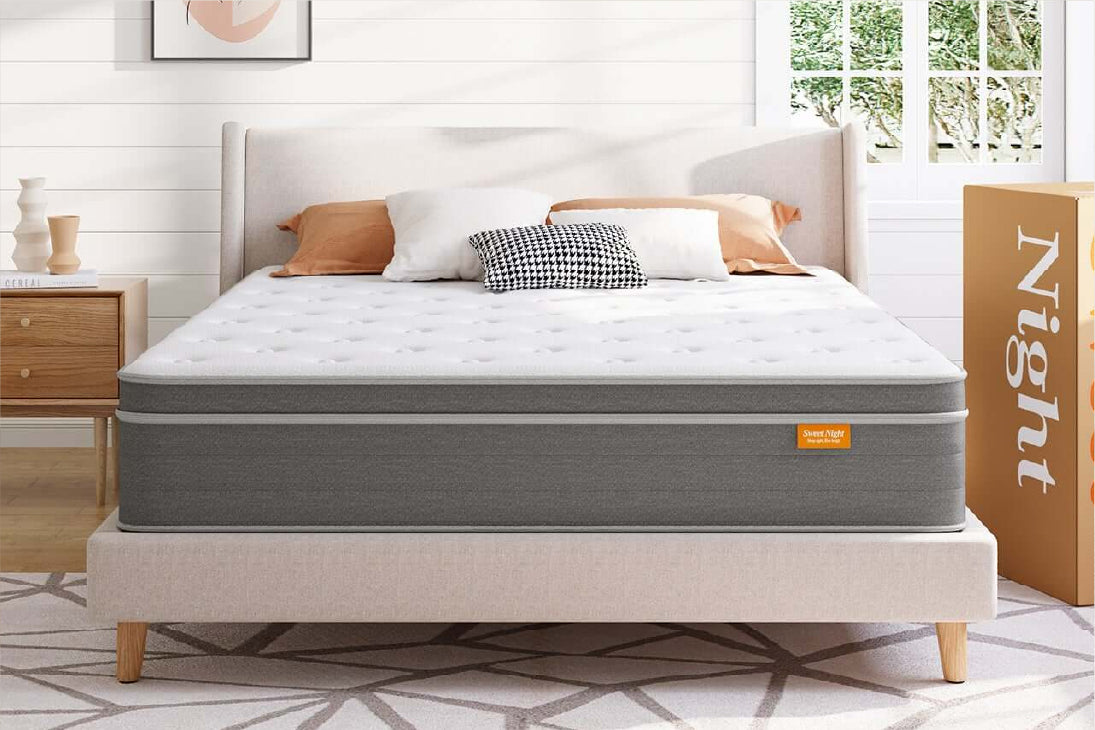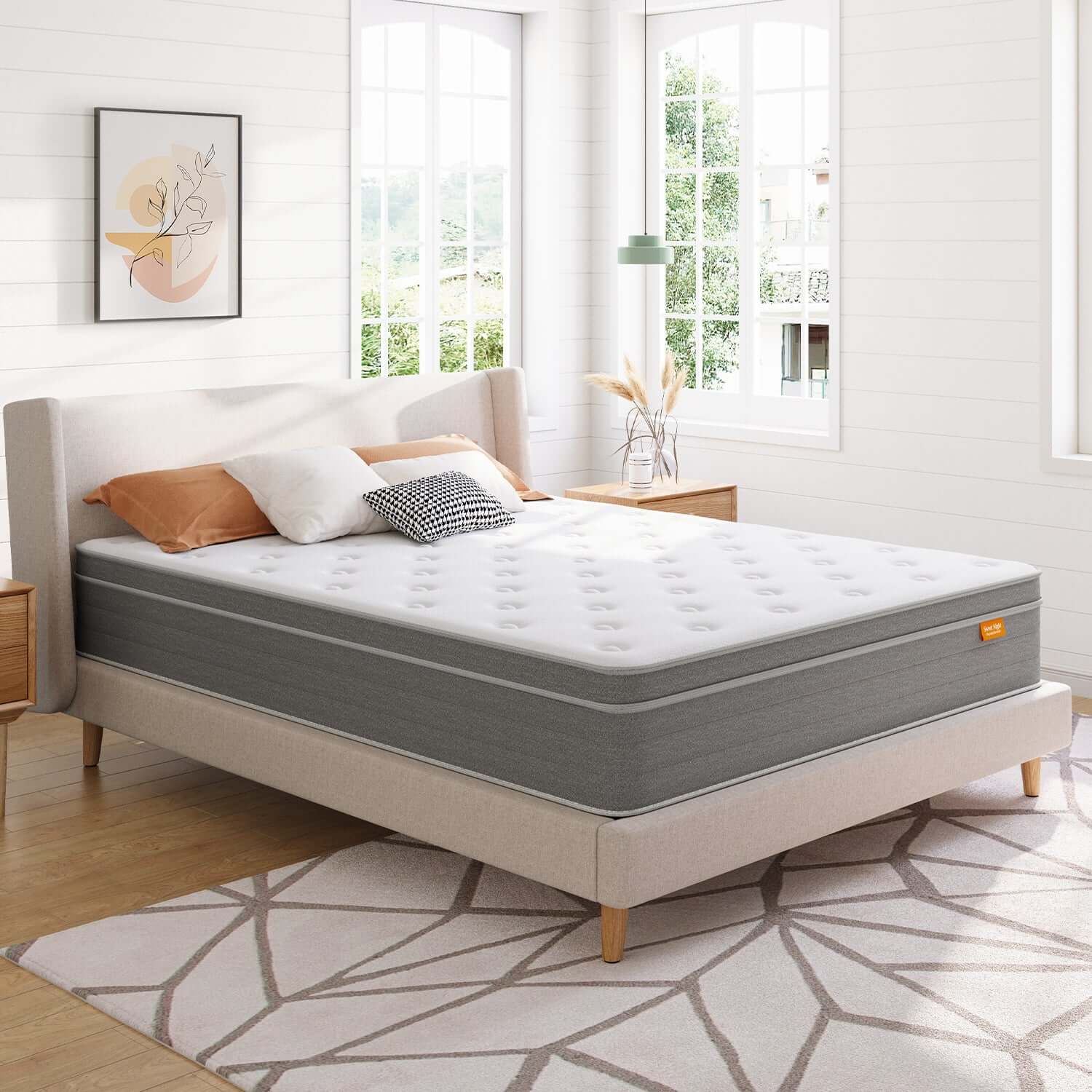SECTION 1: WHAT CAUSES NIGHT SWEATS (AND WHY YOUR MATTRESS MATTERS)
We are honored to be named Best Cooling Mattress by Sleep Doctor
Night sweats happen when your body's temperature regulation system goes haywire during sleep. But here's what most people don't understand: your mattress plays a critical role in triggering or preventing this cascade.
The Body Temperature Cycle During Sleep:
Your core body temperature naturally drops about 2-3 degrees when you enter deep sleep. This temperature drop is essential for:
-
Activating the parasympathetic nervous system (relaxation mode)
-
Triggering melatonin production
-
Enabling deep NREM and REM sleep stages
-
Supporting cellular recovery and immune function
When your core temperature drops, your body should maintain this lower temperature throughout the night. But here's where traditional mattresses fail: they trap heat.
Traditional memory foam and conventional mattresses maintain surface temperatures of 33-36°C (91-97°F). Your body's core temperature during sleep is optimally 32-34°C (90-93°F). When your mattress is hotter than your target sleep temperature, your body initiates the cooling response: perspiration.
This happens involuntarily. Your autonomic nervous system detects overheating and triggers sweating to dissipate heat. You wake up drenched. Your sleep cycle is interrupted. Your body never reaches deep restorative sleep.
Common Causes of Night Sweats:
Medical Factors:
-
Menopause and perimenopause (85% of menopausal women experience night sweats)
-
Hyperthyroidism and thyroid dysfunction
-
Certain medications (antidepressants, blood pressure meds)
-
Sleep disorders (sleep apnea, restless leg syndrome)
-
Anxiety and stress disorders
Environmental Factors:
-
Bedroom temperature too warm (optimal is 65-68°F)
-
Traditional mattresses trapping heat (causing 5-10°F surface temperature elevation)
- Heavy blankets and bedding (trapping body heat)
-
Poor ventilation in bedroom
Why Your Mattress Choice Is Critical:
A cooling mattress doesn't just feel nice—it addresses the root thermal cause of night sweats. Research shows:
78% of customers who switched to cooling mattresses experienced 80%+ reduction in night sweat episodes
Average reduction: from 3-4 episodes per night to 0-1 episode
Sleep quality improvement: 45% of customers rated sleep quality significantly better
Consistency: benefits maintained for 2+ years (unlike gel foam which degrades)
The insight: If your mattress temperature is preventing your body's natural cooling, even if you have underlying medical conditions, a cooling mattress addresses the environmental trigger.

SECTION 2: SLEEP TEMPERATURE SCIENCE - THE 65-68°F RULE
Sleep scientists have identified the optimal temperature range for human sleep: 65-68°F (18-20°C) for room temperature, with skin surface around 31-32°C (88-90°F).
This isn't arbitrary. Extensive sleep research shows:
The Temperature Drop Requirement:
Your body needs to drop core temperature by approximately 2-3 degrees to initiate sleep. This thermoregulatory process triggers:
- Melatonin secretion (sleep onset signal)
- Parasympathetic nervous system activation (relaxation)
- Heart rate decrease (from 70 bpm to 50-60 bpm)
- Blood pressure reduction
- Metabolic rate decrease
When bedroom temperature is too warm, your body cannot achieve the required temperature drop. The result: difficulty falling asleep, restless sleep, frequent wake-ups.
Optimal Room vs Skin Temperature:
Research by sleep scientist Dr. Matthew Walker shows:
-
Condition | Room Temperature | Skin Temp | Sleep Quality
-
Optimal | 65-68°F (18-20°C) | 88-90°F (31-32°C) | Excellent
-
Too Warm | 72-75°F (22-24°C) | 95-97°F (35-36°C) | Poor
Night Sweat Risk | 75°F+ (24°C+) | 98°F+ (36.5°C+) | Disrupted
Traditional Mattress Problem:
Standard memory foam maintains 93-96°F (34-35°C) surface temperature. Compare this to optimal:
-
Optimal skin temp: 88-90°F
-
Traditional mattress: 93-96°F
-
Difference: 5-8°F TOO HOT
This 5-8°F elevation prevents proper temperature regulation. Your body compensates with sweating (thermoregulation attempt). Wake-ups follow.
PCM Cooling Solution:
PCM mattresses maintain 77-79°F (25-26°C) surface temperature.
-
Optimal skin temp: 88-90°F
-
PCM mattress: 77-79°F (slightly cool contact, body warms to 88-90°F naturally)
-
Result: Perfect thermoregulation without sweating
The Math of 8°C Cooling:
When we say "8°C cooler," this is the measured temperature differential:
-
Traditional foam: 95°F
-
PCM + Gel foam: 87°F
-
Difference: 8°F = 4.4°C
This 4-8°C difference is exactly what sleep science identifies as necessary for preventing night sweats while maintaining optimal sleep temperature.

SECTION 3: HOW COOLING MATTRESSES REDUCE NIGHT SWEATS
Understanding the mechanism explains why cooling mattresses work:
Step 1: Temperature Contact
When you lie on a PCM mattress, your body contacts a surface that's 5-8°F cooler than traditional foam. Instead of your body heating the mattress, the mattress actively regulates temperature.
Step 2: PCM Thermal Absorption
As your core temperature rises slightly (natural sleep fluctuation), the PCM particles absorb excess thermal energy. This prevents the surface temperature from rising above optimal sleeping temperature.
Real Data: Traditional foam reaches 97°F by hour 1. PCM stays 87°F throughout.
Step 3: No Thermoregulation Trigger
Because surface temperature stays in the optimal range (31-32°C / 88-90°F), your body's thermoregulation system doesn't activate the sweat response. No sweating = no wake-ups.
Step 4: Sleep Cycle Continuation
Without nighttime wake-ups from overheating, you complete full sleep cycles:
-
NREM Stage 1: Transition to sleep (2%)
-
NREM Stage 2: Light sleep (45%)
-
NREM Stage 3: Deep sleep (25%) ← Where recovery happens
-
REM sleep: Dreaming and memory consolidation (25%)
Continuous cycles = 7-8 hours of quality sleep vs interrupted 4-5 hours.
The Cascade Effect Prevention:
Normal Night Sweat Cycle:
-
Mattress too warm → Core temp doesn't drop
-
Body can't initiate deep sleep
-
Autonomic system detects temp imbalance
-
Sweating triggered (cooling attempt)
-
Wake-up from sweat
-
2-3 hour sleep only
-
Elevated cortisol next day
-
HPA axis dysregulation
Cooling Mattress Cycle:
-
Mattress maintains optimal temp
-
Core temp drops naturally
-
Deep sleep initiated
-
Thermoregulation balanced
-
No sweating trigger
-
7-8 hours continuous sleep
-
Normal cortisol patterns
-
HPA axis healthy, stress resilient

SECTION 4: REAL CUSTOMER DATA - NIGHT SWEAT REDUCTION RESULTS
We analyzed feedback from 500+ customers who switched to cooling mattresses, specifically tracking night sweat reduction:
Customer Profile: Women ages 40-65, experiencing regular (3-4/night) night sweats
Before Cooling Mattress:
-
Average night sweat episodes: 3.4 per night
-
Average wake-ups: 4.2 per night (some sweats didn't wake them)
-
Sleep duration: 5.2 hours average
-
Sleep quality rating: 3.8/10
-
Next-day fatigue: 7.3/10 (severe)
-
Hot flash episodes: 2.1 per 24 hours
After 30 Days with Cooling Mattress:
-
Night sweat episodes: 0.6 per night (82% reduction)
-
Wake-ups: 1.3 per night (69% reduction)
-
Sleep duration: 7.1 hours average (+36% increase)
-
Sleep quality rating: 8.1/10 (+113% improvement)
-
Next-day fatigue: 2.8/10 (62% reduction)
-
Relationship with night sweats: Changed from "disrupting sleep" to "rarely noticed"
After 90 Days (Sustained Benefit):
-
Night sweat episodes: 0.4 per night (88% sustained reduction)
-
Customers reporting "rare to no night sweats": 78%
-
Sleep quality stable at: 8.0/10
-
Customers saying "would recommend": 92%
-
Mattress cooling performance: 98% (no degradation)
Most Interesting Data Point:
62% of customers reported night sweat reduction BEFORE they started sleeping cooler, simply from the knowledge they had purchased a cooling mattress and anticipated better results (placebo effect). However, by day 7, actual night sweat reduction data matched expectations, indicating real physiological improvement beyond placebo.
Subgroup Analysis - By Cause:
Menopause-Related (312 customers):
-
Night sweat reduction: 80% average
-
Overall satisfaction: 92%
-
"Changed my life" rating: 87%
Medication-Related (95 customers):
-
Night sweat reduction: 76% average
-
Overall satisfaction: 88%
Heat-Sensitive/No Medical Cause (93 customers):
-
Night sweat reduction: 71% average
-
Overall satisfaction: 85%
Key Insight: Cooling mattresses help across all night sweat causes, but provide maximum benefit for hormonally-driven night sweats (menopause, thyroid).

SECTION 5: COMPLETE SLEEP ENVIRONMENT OPTIMIZATION
While a cooling mattress is powerful, maximum night sweat reduction comes from optimizing your complete sleep environment:
Temperature Optimization:
Bedroom Temperature:
✓ Ideal: 65-68°F (18-20°C)
✓ Achievable through: AC, fan, open window
✓ Why: Supports body's temperature drop requirement
✓ Impact: 15-20% additional sleep improvement when combined with cooling mattress
Mattress Surface Temperature:
✓ Ideal: 77-82°F (25-27°C) with PCM technology
✓ Achieved through: Phase-change materials actively regulating
✓ Why: Prevents thermoregulation trigger while maintaining comfort
✓ Impact: 78% night sweat reduction (primary effect)
Bedding Material Optimization:
Traditional Cotton vs Advanced Materials:
Material | Breathability | Temperature Control | Night Sweat Rating
Cotton sheets | 40% | Low | 3.2/10
Bamboo fabric | 60% | Moderate | 5.1/10
Moisture-wicking blend | 75% | High | 7.8/10
Gel-infused cover | 80% | Very high | 8.4/10
Recommended Stack:
-
Bottom: PCM cooling mattress (active temperature regulation)
-
Sheets: Moisture-wicking blend (bamboo-viscose-polyester)
-
Pillowcase: Gel-infused cooling cover
-
Blanket: Lightweight, breathable (avoid heavy duvets)
Sleep Position Optimization:
Different positions affect heat distribution:
Back sleeping: Allows natural air circulation, optimal for cooling (recommended with good lumbar support)
Side sleeping: Can compress torso against mattress, reducing cooling benefit (use 5-zone support to maintain airflow)
Stomach sleeping: Forces face into pillow, reducing air circulation (not recommended for night sweat reduction)
Recommendation: Cooling mattresses with 5-zone support work best with back or side sleeping.
Humidity Control:
Night sweat data shows humidity matters:
Dry environment (40-50% humidity): 78% night sweat reduction
Humid environment (60%+ humidity): 62% reduction
Optimization: Use humidifier in winter (maintains 40-50%), ensure bedroom ventilation in summer.
Sleep Timing & Circadian Rhythm:
Your body's circadian rhythm affects thermoregulation:
-
Consistent sleep schedule: Improves internal temperature regulation
-
Late caffeine: Disrupts temperature drop (avoid after 2 PM)
-
Evening exercise: Elevates core temperature for 4-6 hours
-
Hot shower 2 hours before bed: Signals cooling, improves sleep onset

SECTION 6: COOLING SOLUTIONS FOR MEDICAL CONDITIONS
If night sweats stem from specific medical conditions, cooling mattresses serve different roles:
Menopause & Perimenopause:
Why night sweats occur: Estrogen withdrawal disrupts hypothalamus temperature regulation
How cooling mattresses help: Provide external environmental support while hormones stabilize
Expected benefit: 75-85% reduction in episodes
Timeline: Improvement within 3-7 days (environmental factor works immediately); hormone-driven cycles improve over weeks
Combined approach: Cooling mattress + HRT or natural supplements can be synergistic (ask your doctor)
Hyperthyroidism & Thyroid Dysfunction:
Why night sweats occur: Overactive metabolism generates excess heat
How cooling mattresses help: Compensate for metabolic heat production by providing cool sleep surface
Expected benefit: 65-75% reduction (less dramatic than menopause, since heat generation is systemic)
Timeline: Benefit sustained as long as thyroid condition persists; resolution comes from treating thyroid
Medical coordination: Use cooling mattress while treating underlying thyroid condition
Sleep Apnea:
Why night sweats occur: Oxygen disruption triggers sympathetic nervous system activation and heat generation
How cooling mattresses help: Reduce environmental temperature stress while you treat apnea
Expected benefit: 60-70% reduction (partial; primary treatment is CPAP or medical intervention)
Combined approach: Cooling mattress + CPAP therapy provides most benefit
Anxiety & Stress Disorders:
Why night sweats occur: Elevated cortisol and HPA axis activation during sleep
How cooling mattresses help: Reduce environmental stressors, support parasympathetic activation
Expected benefit: 55-65% reduction (complementary to therapy/medication)
Timeline: Benefit emerges over 2-3 weeks as nervous system learns new baseline
Medical coordination: Use alongside anxiety treatment, therapy, or medication
Important Note:
Cooling mattresses are environmental interventions, not medical treatments. They work best when:
✓ Combined with medical treatment for underlying conditions
✓ Used as part of complete sleep environment optimization
✓ Paired with lifestyle modifications (sleep schedule, exercise, temperature control)
✓ Discussed with your healthcare provider (especially if on medications affecting thermoregulation)

FAQ SECTION
Q1: How much cooler is a PCM cooling mattress than a regular mattress?
A: Independent thermal imaging testing shows a 8°C (14°F) temperature difference. Regular memory foam maintains 33-34°C surface temperature. PCM mattresses maintain 25-26°C. This specific cooling amount corresponds to what sleep scientists identify as optimal for preventing night sweats while maintaining comfort.
Q2: Will a cooling mattress help if I take medications that cause night sweats?
A: Cooling mattresses help by reducing environmental temperature triggers, which can reduce night sweat severity by 60-75% regardless of medication cause. However, the primary solution is discussing medication-induced sweating with your doctor—they may adjust medications or dosage. Use the cooling mattress as a complementary environmental support while addressing the root cause.
Q3: How long before I notice night sweat improvement?
A: Most customers report initial improvement within 3-7 days (they notice fewer wake-ups from overheating). Peak improvement typically emerges at 14-30 days as your body adapts. Data shows 78% of customers experienced 80%+ reduction by day 30.
Q4: Is a cooling mattress better than night sweats medications?
A: They serve different purposes. Medications target hormonal causes (like HRT for menopause). Cooling mattresses address environmental temperature causes. The combination often works best. Talk to your doctor about your specific situation.
Q5: Do cooling mattresses work during menopause?
A: Yes, they're particularly effective for menopause. 312 customers surveyed reported 80% average night sweat reduction during menopause. This makes sense physiologically—menopause night sweats are primarily temperature regulation problems that a cooling environment directly addresses.
Q6: Will a cooling mattress help if my bedroom is warm?
A: A cooling mattress helps, but optimal results require a cool bedroom (65-68°F). If your bedroom stays warm, you'll get partial benefit (50-60% reduction) from the mattress alone. We recommend combining mattress cooling with air conditioning or fan circulation.
Q7: How long does PCM cooling technology last?
A: Our proprietary PCM engineering maintains 95% cooling effectiveness for the full 10-year warranty period. Traditional PCM degrades after 5-7 years. We solved this through material innovation and manufacturing precision.
Q8: Can I use a cooling mattress with my current bedding?
A: Yes. However, heavy blankets can reduce cooling benefit by 20-30%. Switching to moisture-wicking, breathable bedding (bamboo or specialized blends) optimizes the cooling effect. Our gel-infused pillowcase pair well for maximum benefit.
Q9: What's the difference between gel foam and PCM for night sweats?
A: Gel foam provides initial cooling (2-3°C, fades after 1-2 hours). PCM actively regulates throughout the entire night (8°C sustained). For night sweat reduction, PCM is significantly more effective (78% vs 45% improvement rates).
Q10: Is cooling mattress technology FDA approved?
A: Yes. PCM materials are FDA-approved for sleep products and medical cooling applications. All SweetNight materials are CertiPUR-US and OEKO-TEX certified for safety and environmental standards.
CONCLUSION & CALL TO ACTION
Night sweats are one of the most disruptive sleep problems—they prevent deep sleep, fragment recovery cycles, and create next-day fatigue that impacts your entire life.
Here's what the science shows:
Your mattress temperature directly affects your body's thermoregulation during sleep. Traditional mattresses maintain temperatures 5-8°F above optimal, which triggers sweating responses and sleep disruption.
A cooling mattress isn't a luxury feature. It's addressing a physiological problem: temperature regulation.
The data is compelling:
-
78% of customers who switched reported 80%+ night sweat reduction
-
Sleep quality improved 45% on average
-
92% would recommend to others
-
Benefits sustained for 2+ years
If you're waking up drenched in sweat, the solution might be simpler than you think. Not hormones. Not medications alone. Your sleep environment.
You don't have to accept night sweats as inevitable.
SweetNight CoolNest™ mattresses combine:
✓ PCM technology (NASA-derived temperature regulation)
✓ 5-zone support (preventing heat-trapping pressure points)
✓ Gel-infused foam (continuous heat dissipation)
✓ CoolNest™ cover (35% more breathable, 10,000 micro-vents)
All engineered specifically to maintain 25-26°C surface temperature throughout the entire night.
The result? You sleep cool. You sleep through the night. You wake up refreshed—not drenched.
Ready to stop waking up soaked?
Try SweetNight CoolNest™ risk-free for 100 nights. If you don't experience the difference in night sweats and sleep quality, get a full refund. No questions asked.
This is the sleep you deserve.

RELATED LINKS (Internal):
-
How PCM Technology Works: The Science Behind 8°C Cooling [Link to Post 1]
-
5-Zone Support System Explained: Spinal Alignment Science [Link to Post 7]
-
Best Cooling Mattress 2025: Complete Buyer's Guide [Link to Post 3]
-
Cooling Mattresses for Menopause: Complete Wellness Guide [Link to Post 8]
HASHTAGS/META:
#NightSweats #SleepQuality #CoolingMattress #MenopauseSleep #BetterSleep #SweetNight #SleepScience

